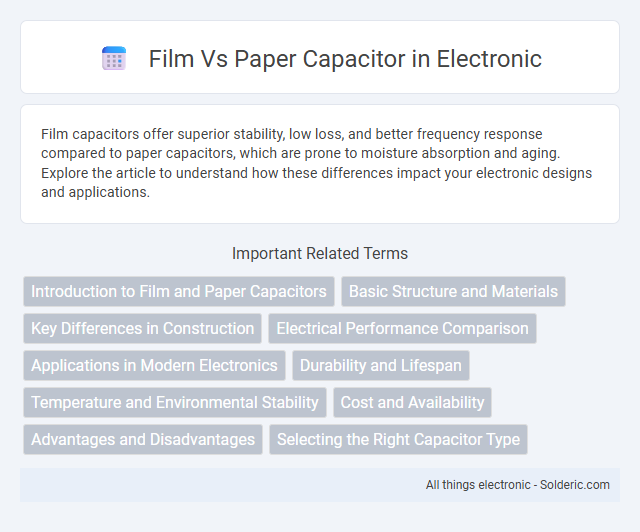Film capacitors offer superior stability, low loss, and better frequency response compared to paper capacitors, which are prone to moisture absorption and aging. Explore the article to understand how these differences impact your electronic designs and applications.
Comparison Table
| Feature | Film Capacitor | Paper Capacitor |
|---|---|---|
| Dielectric Material | Polyester, polypropylene, or other plastic films | Impregnated paper |
| Dielectric Loss | Low dielectric loss | Higher dielectric loss |
| Stability | High thermal and electrical stability | Lower stability; prone to moisture absorption |
| Voltage Rating | Up to several kV | Typically lower voltage ratings |
| Size | Compact for given capacitance | Larger size for similar values |
| Frequency Response | Good for high-frequency applications | Limited high-frequency performance |
| Reliability | High reliability and longevity | Less reliable; aging issues |
| Cost | Generally higher cost | Lower cost |
| Applications | High voltage, filtering, timing circuits | Power factor correction, legacy electronics |
Introduction to Film and Paper Capacitors
Film capacitors use thin plastic films as the dielectric, offering high stability, low loss, and excellent frequency response, making them ideal for precision electronic circuits. Paper capacitors utilize impregnated paper as the dielectric, providing high voltage capabilities but with lower insulation resistance and higher losses compared to film types. Your choice between film and paper capacitors depends on the required performance characteristics such as temperature stability, frequency range, and reliability in the specific application.
Basic Structure and Materials
Film capacitors consist of thin plastic films such as polyester, polypropylene, or polyphenylene sulfide as dielectric materials, layered between metal foil electrodes or metallized film electrodes. Paper capacitors use impregnated paper with oil or other insulating liquids as the dielectric material, sandwiched between aluminum foil electrodes. The structure of film capacitors provides superior stability and lower losses compared to the bulkier and more moisture-sensitive paper capacitors.
Key Differences in Construction
Film capacitors consist of a plastic film dielectric material, typically polyester, polypropylene, or polycarbonate, wound or stacked between metal foil electrodes, offering high insulation resistance and stability. Paper capacitors use impregnated paper as the dielectric, sandwiched between metal foils and often soaked in oil or wax for improved insulation and moisture resistance. The key construction difference lies in the dielectric material--synthetic polymer films provide better electrical characteristics and longevity, while paper dielectrics tend to be bulkier and less durable.
Electrical Performance Comparison
Film capacitors offer superior electrical performance with low equivalent series resistance (ESR) and excellent stability over a wide frequency range, making them ideal for high-frequency applications. Paper capacitors tend to exhibit higher dielectric losses and reduced reliability due to moisture absorption and aging effects, which negatively impact their capacitance stability and insulation resistance. Your choice should consider that film capacitors generally provide better voltage withstand, lower dissipation factor, and extended lifespan compared to traditional paper capacitors.
Applications in Modern Electronics
Film capacitors offer superior stability and low dielectric loss, making them ideal for high-frequency circuits and precision electronic devices, whereas paper capacitors, once common, are largely replaced due to their higher leakage current and poor moisture resistance. Modern electronics extensively use film capacitors in power supplies, audio equipment, and signal processing for their reliability and long operational life. Despite this, paper capacitors occasionally appear in vintage or specialized restoration projects where original component authenticity is required.
Durability and Lifespan
Film capacitors exhibit superior durability and a longer lifespan compared to paper capacitors due to their stable polyester or polypropylene dielectric materials, which resist moisture and thermal degradation. Paper capacitors are prone to aging and breakdown from moisture absorption and heat, significantly reducing their operational life. Choosing film capacitors enhances the reliability and longevity of Your electronic circuits, especially in demanding environments.
Temperature and Environmental Stability
Film capacitors maintain stable capacitance and low equivalent series resistance (ESR) across a wide temperature range, typically from -55degC to 105degC, ensuring reliable performance in harsh environments. Paper capacitors exhibit less temperature stability due to their organic insulation, limiting operation to narrower temperature bands and increasing susceptibility to moisture absorption, which accelerates dielectric degradation. The superior environmental robustness of film capacitors makes them ideal for applications requiring high reliability and long-term stability under varying conditions.
Cost and Availability
Film capacitors generally offer affordable pricing and wide availability due to mass production and standardized sizes, making them cost-effective for various electronic applications. Paper capacitors, being older technology, tend to be less common and more expensive due to limited production and specialized usage in vintage or niche equipment. Your choice between film and paper capacitors should consider budget constraints and the accessibility of components based on current market trends.
Advantages and Disadvantages
Film capacitors offer higher stability, lower dielectric losses, and better temperature tolerance compared to paper capacitors, making them ideal for high-frequency applications. However, paper capacitors can handle higher surge currents and have a lower cost, though they are prone to moisture absorption and reduced lifespan. When choosing a capacitor for your project, consider the performance needs versus budget constraints to determine the best option.
Selecting the Right Capacitor Type
Selecting the right capacitor type depends on your specific application requirements such as voltage rating, tolerance, and stability. Film capacitors offer superior reliability, low ESR, and excellent frequency characteristics, making them ideal for precision circuits and high-frequency applications. Paper capacitors, while cost-effective and suitable for high-voltage uses, generally have higher losses and lower durability compared to modern film capacitors, so consider these factors when choosing the best option for your project.
Film vs paper capacitor Infographic

 solderic.com
solderic.com